Effects of Spraying Calcium Fertilizer on Photosynthesis, Mineral Content, Sugar–Acid Metabolism and Fruit Quality of Fuji Apples
Abstract
:1. Introduction
2. Materials and Methods
2.1. Basic Information of Test Site
2.2. Test Design
2.3. Measuring Methods
2.3.1. Measurements of Net Photosynthetic Rate (Pn) and Other Gas Exchange Parameters of Leaves
2.3.2. Measurements of Chlorophyll and Carotenoid Contents
volume × dilution times/sample weight (g)
2.3.3. Determination of Mineral Element Content
2.3.4. Determination of Sugar and Acid Content of Fruit
2.3.5. Determination of Sugar Metabolism-Related Enzyme Activity in Fruit
2.3.6. Determination of Enzyme Activity Related to Acid Metabolism in Fruit
2.3.7. Determination of Other Fruit Quality Indexes
2.4. Statistical Analysis
3. Results
3.1. Effects of Spraying Calcium Fertilizer on the Qualities of Apple Fruits
3.2. Effects of Spraying Calcium Fertilizer on Sugar and Acid Accumulation of ‘Fuji’ Apple Fruit
3.3. Effects of Spraying Calcium Fertilizer on Mineral Element Content of Apple Leaves and Fruits
3.3.1. Effects of Spraying Calcium Fertilizer on Mineral Element Content of Apple Leaves
3.3.2. Effects of Spraying Calcium Fertilizer on Mineral Element Content of Apple Fruits
3.4. Effects of Spraying Calcium Fertilizer on Chlorophyll (Chl) and Carotenoid (Car) Contents in Apple Leaves
3.5. Effects of Spraying Calcium Fertilizer on Net Photosynthetic Rate (Pn) of Apple Leaves
3.6. Effects of Spraying Calcium Fertilizer on Other Photosynthetic Parameters of Apple Leaves
3.7. Effects of Spraying Calcium Fertilizer on the Activities of Major Enzymes Related to Sugar and Acid Metabolism in ‘Fuji’ Apple Fruit
3.7.1. Effects of Spraying Calcium Fertilizer on the Activities of Major Enzymes Related to Sugar Metabolism in ‘Fuji’ Apple Fruit
3.7.2. Effects of Spraying Calcium Fertilizer on the Activity of Main Enzymes Related to Acid Metabolism in ‘Fuji’ Apple Fruit
4. Discussion
4.1. Spraying Calcium Fertilizer to Improve Fruit Quality
4.2. Spraying Calcium Fertilizer to Increase Sugar and Reduce Acid
4.3. Spraying Calcium Fertilizer to Improve the Photosynthetic Capacity of Apple Leaves
4.4. Spraying Calcium Fertilizer Affects the Absorption and Accumulation of Mineral Nutrients in Apples
5. Conclusions
Author Contributions
Funding
Institutional Review Board Statement
Informed Consent Statement
Data Availability Statement
Conflicts of Interest
References
- Ge, Y.Q.; Li, H.F.; Wang, C.Y.; Wei, X.X.; Su, J.; Dong, S.S. Status and sustainable development proposals of apple industry in china. Xian Dai Shi Pin. 2021, 11, 4–6. [Google Scholar] [CrossRef]
- Si, Y.S.; Sankaran, S. Computed tomography imaging−-based bitter pit evaluation in apples. Biosyst. Eng. 2016, 151, 9–16. [Google Scholar] [CrossRef] [Green Version]
- Wang, G.P.; Zhai, H.; Chen, R.; Lu, C.; Xue, X.M.; Wang, J.Z. Effects of microenvironment of different types of fruit bags on fruit development and quality of Fuji apple. Jiangsu Agric. Sci. 2019, 47, 5. [Google Scholar] [CrossRef]
- Tomala, K. Orchard factors affecting fruit storage quality and prediction of harvest date of apples. Acta Hortic. 1999, 485, 373–382. [Google Scholar] [CrossRef]
- Xue, X.M.; Han, X.P.; Chen, R.; Wang, L.P.; Nie, P.X.; Wang, J.Z. Study on the Suitable Load of Dwarfing Interstock ‘Yanfu 3’ Apple in Full Fruit Period. China Fruits 2020, 01, 87–91. [Google Scholar] [CrossRef]
- Miqueloto, A.; Amarante, C.; Steffens, C.A.; Santos, A.D.; Mitcham, E. Relationship between xylem functionality, calcium content and the incidence of bitter pit in apple fruit. Sci. Hortic. 2014, 165, 319–323. [Google Scholar] [CrossRef]
- Cvtd, A.; Miqueloto, A.; de Freitas, S.T.; Steffens, C.A.; Silveira, J.P.G.; Corrêa, T.R. Fruit sampling methods to quantify calcium and magnesium contents to predict bitter pit development in ‘Fuji’ apple: A multivariate approach. Sci. Hortic. 2013, 157, 19–23. [Google Scholar] [CrossRef]
- Wang, Y.D. Studies on the Effects of Calcium on Watercore and Sorbitol Content in ‘Yueguan’ Apple Fruit. Master’s Thesis, Shenyang Agricultural University, Shenyang, China, 2018. [Google Scholar]
- Torres, E.; Recasens, I.; Lordan, J.; Alegre, S. Combination of strategies to supply calcium and reduce bitter pit in ‘Golden Delicious’ apples. Sci. Hortic. 2017, 217, 179–188. [Google Scholar] [CrossRef] [Green Version]
- Yang, L.L.; Lu, K.Z.; Zou, P.; Qi, G.H.; Zhang, X.M.; Li, H.; Guo, S.P. Correlation analysis of apple bitter pit with fruit quality and mineral element contents in fruits. Nonwood For. Res. 2019, 37, 134–140. [Google Scholar] [CrossRef]
- Yang, L.L.; Lu, K.Z.; Zou, P.; Qi, G.H.; Zhang, X.M.; Li, H.; Guo, S.P. Optimum application amount and times of calcium nitrate for better fruit quality and lower incidence of apple bitter pit. J. Plant Nutr. Fert. 2020, 26, 765–772. [Google Scholar] [CrossRef]
- Peng, Y.; Wang, J.X.; Ma, Y.R.; Liu, P.; Wang, Q.G. Inhibitory Effect of Prohexadione-Calcium Combined with Calcium Nitrate on Bitter Pit of Fuji Apple. Food Sci. 2020, 41, 205–211. [Google Scholar] [CrossRef]
- Zhou, W.; Wang, H.; Zhao, L.P.; Lin, B. Study on characteristics of calcium uptake by young fruit of apple (Malus pumila) and its regulation by hormone. Sci. Agric. Sin. 1999, 32, 52–58. [Google Scholar] [CrossRef]
- Casero, T.; Benavides, A.; Recasens, I.; Rufat, J. Preharvest calcium sprays and fruit calcium absorption in ‘Golden’ apples. Acta Hort. (ISHS) 2002, 594, 467–473. [Google Scholar] [CrossRef]
- Nie, P.X.; Yu, X.M.; Wang, Z.S.; Xue, X.M.; Wang, J.Z. Effects of different calcium foliage fertilizers and spraying period on apple bitter pit disease and fruit quality. J. Hebei Agric. Sci. 2017, 21, 47–49. [Google Scholar] [CrossRef]
- Yuan, J.W. Effects of Exogenouscalcium on Physiological Characteristics of Fuji Apple. Master’s Dissertation, Ningxia University, Yinchuan, China, 2021. [Google Scholar] [CrossRef]
- Du, Y.J. Study on the Difference of Calcium Content in Apples Varieties and the Method of Supplementing Calcium in ‘Honeycrisp’. Master’s Dissertation, Northwest A&F University, Xianyang, China, 2021. [Google Scholar] [CrossRef]
- Liu, X.Y.; Liu, Y.F.; Yi, B.T.; Sun, Z.Y.; Zhang, S.W.; Ma, M.Z.; Han, X.R. Foliar calcium application alleviates cold stress-−induced photosynthetic inhibition in peanut. J. Plant Nutr. Fert. 2022, 28, 291–301. [Google Scholar] [CrossRef]
- Zhai, J.; Gao, Y.; Zhang, X.W.; Han, L.J.; Bi, H.G.; Li, Q.M.; Ai, X.Z. Effects of Silicon and Calcium on Photosynthesis, Yield and Quality of Cucumber in Solar-greenhouse. Acta Hortic. Sin. 2019, 46, 701–713. [Google Scholar] [CrossRef]
- Lin, S.M.; Meng, W.W.; Nan, Z.W.; Xu, J.; Zhang, Z.; Li, L.; Guo, F.; Li, X.G.; Wan, S.B. Effects of calcium application on photosynthetic characteristics, sugar metabolism in late growth stage and yield of peanut under inter-−cropping and shading. Chin. J. Oil Crop. Sci. 2020, 42, 277–284. [Google Scholar] [CrossRef]
- Zhou, J.; Xiao, W.; Chen, X.D.; Gao, D.S.; Li, L. Effect of exogenous calcium on leaf photosynthetic characteristics and fruit quality of ‘Whangkeumbae’ pear. Plant Physiol. J. 2018, 54, 449–455. [Google Scholar] [CrossRef]
- Huang, Y.; Wen, L.; Pang, Y.Z.; Huang, B.Y.; Wang, J.; Lv, X.L. Effect of spraying calcium on sugar and acid accumulation in ‘Summer Black’ grape. China Soils Fert. 2020, 2, 166–172. [Google Scholar] [CrossRef]
- Ou, Z.F.; Liu, L.; Jiang, Y.M.; Wei, S.C.; Li, H. Effects of preharvest calcium sprays on quality and storage properties of Red Fuji apple (Malus pumila Mill). Food Ferment. Ind. 2013, 39, 192–196. [Google Scholar] [CrossRef]
- Zhou, J.; Xiao, W.; Chen, X.D.; Zhang, Z.J.; Wen, B.B.; Song, W.L.; Gao, D.S.; Li, L. Effects of spraying calcium on the postharvest storability of ‘Whangkeumbae’ pear during young fruit period. Acta Phytophysiol. Sin. 2018, 54, 1038–1044. [Google Scholar] [CrossRef]
- Ranjbar, S.; Rahemi, M.; Ramezanian, A. Comparison of nano-−calcium and calcium chloride spray on postharvest quality and cell wall enzymes activity in apple cv. Red Delicious. Sci. Hortic. 2018, 240, 57–64. [Google Scholar] [CrossRef]
- Si, L.J.; Han, Q. Climate Impact Assessment of Tai’an City in 2020. J. Agric. Catastrophol. 2020, 10, 32–33. [Google Scholar] [CrossRef]
- Zhao, S.J.; Shi, G.A.; Dong, X.C. Techniques of Plant Physiological of Experiment, 1st ed.; Agricultural Science and Technology Press: Beijing, China, 2002; pp. 55–57. [Google Scholar]
- Lu, Y.Q.; Liuh, P.; Wang, Y.; Zhang, X.Z.; Han, Z.H. Synergistic roles of leaf boron and calcium during the growing season in affecting sugar and starch accumulation in ripening apple fruit. Acta Physiol. Plant. 2013, 35, 2483–2492. [Google Scholar] [CrossRef]
- Hu, G.J.; Liu, J.F.; Liu, J.M. Determination of Nutritional Components of Fruit Trees t, 1st ed.; Tai’an Press and Publication Bureau: Tai’an, China, 1997; p. 5. [Google Scholar]
- Tong, Y.A.; Zhou, H.J. Nutritional Diagnosis of Fruit Trees, 1st ed.; Agricultural Press: Beijing, China, 1982; pp. 113–115. [Google Scholar]
- Hu, Z.Q.; Wang, H.C.; Hu, G.B. Measurement of sugars, organic acids and vitamin C in litchi fruit by high performance liquid chromatography. J. Fruit Sci. 2005, 5, 582–585. [Google Scholar] [CrossRef]
- Chen, M.; Jiang, Q.; Yin, X.R.; Lin, Q.; Chen, J.Y.; Allan, A.C.; Xu, C.J.; Chen, K.S. Effect of hot air treatment on organic acid and sugar-metabolism in ponkan (citrus reticu-lata) fruit. Sci. Hortic. 2012, 147, 118–125. [Google Scholar] [CrossRef]
- Lowell, C.; Tomlinson, P.T.; Koch, K.E. Sucrose-metabolizing enzymes in transport tissues and adjacent sink structures in developing citrus fruit. Plant Physiol. 1989, 90, 1394–1402. [Google Scholar] [CrossRef] [Green Version]
- Zhu, Y.J.; Komor, E.; Moore, P.H. Sucrose accumulation in the sugarcane stem is regulated by the difference between the activities of soluble acid invertase and sucrose phosphate synthase. Plant Physiol. 1997, 115, 609–616. [Google Scholar] [CrossRef]
- Huber, S.C. Role of sucrose-phosphate synthase in partitioning of carbon in leaves. Plant Physiol. 1983, 71, 818–821. [Google Scholar] [CrossRef] [Green Version]
- Hubbard, N.L.; Huber, S.C.; Pharr, D.M. Sucrose phosphate synthase and acid invertase as determinants of sucrose concentration in developing muskmelon (Cucumis melo L.) fruits. Plant Physiol. 1989, 91, 1527–1534. [Google Scholar] [CrossRef] [Green Version]
- Zhang, X. Effects of Different Potassium Application Levels on Physiological Metabolism of Sugar and Acid in “Gala” Apple Fruit. Master’s Thesis, Northwest A&F University, Xianyang, China, 2016. [Google Scholar]
- Sun, Z.; Ma, C.M.; Zhou, J.; Zhu, S.H. Cloning, expression, purification and assay of sorbito dehydrogenase from “Feicheng” peach fruit (Prunus persica). Braz. Arch. Biol. Technol. 2013, 56, 531–539. [Google Scholar] [CrossRef]
- Park, S.W.; Song, K.J.; Kim, M.Y.; Hwang, J.H.; Shin, Y.U. Molecular cloning and characterization of four cDNAs encoding the isoforms of NAD dependent sorbitol dehydrogenase from the Fuji apple. Plant Sci. 2002, 162, 513–519. [Google Scholar] [CrossRef]
- Hirai, M.; Ueno, I. Development of citrus fruits: Fruit development and enzymatic changes in juice vesicle tissue. Plant Cell Physiol. 1977, 18, 791–799. [Google Scholar] [CrossRef]
- Luo, A.C.; Yang, X.H.; Deng, Y.Y.; Li, C.F.; Xiang, K.S.; Li, D.G. Organic acid concentrations and the relative enzymatic changes during the development of citrus fruits. Sci. Agric. Sin. 2003, 36, 941–944. [Google Scholar] [CrossRef]
- Wang, G.P.; Xue, X.M.; Lu, C.; Nie, P.X.; Wang, J.Z. Study on the effect of harvest time on the quality of Gala and Fuji apples. Deciduous Fruits 2016, 48, 9–11. [Google Scholar] [CrossRef]
- NY/T 1086-2006; Agricultural Industry Standard of the People’s Republic of China. Technical Specifications for Apple Picking; Ministry of Agriculture of the People’s Republic of China: Beijing, China, 2006.
- National Standard of the People’s Republic of China. Determination of Vitamin C Content in Fruits and Vegetables; Agricultural Press: Beijing, China, 1986. [Google Scholar]
- Li, G.L.; Su, R.Y.; Shen, J. Studies on the nutritional ranges in some deciduous. Acta Hortic. Sin. 1987, 14, 81–89. [Google Scholar]
- Chen, X.W.; Chen, J.B.; Cai, D.B.; Zhang, M.Y.; Zhang, J. Influences of Calcium Fertilizer on Jufeng Grape Yield and Quality. J. Agric. Sci. Technol.-China 2019, 21, 140–146. [Google Scholar] [CrossRef]
- Zhang, J.; Gao, Z.Y.; Yang, H.J.; Yang, Y.Z.; Zhao, Z.Y. Study on Anatomy and Fruit Texture Related Enzymes in Apple (Malus × domestica) Cultivars ‘Qinguan’ and ‘Fuji’. Northwest China J. Agric. Sci. 2015, 24, 88–94. [Google Scholar] [CrossRef]
- Zhang, X.C. Effects of Calcium Fertilizer Spraying on Blueberry Quality and Pectin Degradation; Sichuan Agricultural University: Chengdu, China, 2019. [Google Scholar] [CrossRef]
- Ifigeneia, M.; Koukounaras, A.; Kostas, S.; Patelou, E.; Kanellis, A.K. Regulation of vitamin C accumulation for improved tomato fruit quality and alleviation of abiotic stress. Genes 2021, 12, 694. [Google Scholar] [CrossRef]
- Zhang, H.; Xiang, Y.L.; He, N.; Liu, X.G.; Liu, H.B.; Fang, L.P.; Zhang, F.; Sun, X.P.; Zhang, D.L.; Li, X.W.; et al. Enhanced vitamin C production mediated by an ABA-Induced PTP-like nucleotidase improves plant drought tolerance in arabidopsis and maize. Mol. Plant 2020, 13, 760–776. [Google Scholar] [CrossRef]
- Gerendás, J.; Führs, H. The significance of magnesium for crop quality. Plant Soil 2013, 368, 101–128. [Google Scholar] [CrossRef] [Green Version]
- Zhou, Y. The Relationship between Citrus Fruit Sugar and Organic Acid Metabolism and Magnesium and Its Mechanism. Ph.D. Dissertation, Huazhong Agricultural University, Wuhan, China, 2020. [Google Scholar]
- Pan, R.C. Plant Physiology, 7th ed.; Higher Education Press: Beijing, China, 2016; pp. 32–38. [Google Scholar]
- Wang, F.; He, C.M.; Li, Q.H.; Lin, C. ffects of exogenous calcium and soil moisture at acicula forming stage of peanut on some physiological characteristics of plants. J. Plant Nutr. Fert. 2013, 19, 623–631. [Google Scholar]
- Lu, Y.L.; Zeng, Q.Y.; Zhou, W.L.; Chen, D.W.; Huang, Y.; Ao, J.H.; Huang, Z.R.; Li, Q.W.; Jiang, Y. Effects of different application amount of lime, magnesium, silicon fertilizers on plant growth and some important physiological indices of sugarcane seedlings. Sugarcane Canesugar 2014, 6, 18–23. [Google Scholar] [CrossRef]
- Hou, J.; Li, J.; Yang, Y.; Wang, Z.; Chang, B.; Yu, X.W.; Yuan, L.Y.; Wang, C.G.; Chen, G.H.; Tang, X.Y.; et al. Physiological and transcriptomic analyses elucidate that exogenous calcium can relieve injuries to potato plants (Solanum tuberosum L.) under weak light. Int. J. Mol. Sci. 2019, 20, 5133. [Google Scholar] [CrossRef] [Green Version]
- Iqbal, Z.; Iqbal, M.S.; Singh, S.P.; Buaboocha, T. Ca2+/calmodulin complex triggers CAMTA transcriptional machinery under stress in plants: Signaling cascade and molecular regulation. Front. Plant Sci. 2020, 11, 598327. [Google Scholar] [CrossRef]
- Yin, D.; Wang, H.; Qi, J. The Enhancement Effect of calcium Ions on ectomycorrhizal fungi-mediated drought resistance in pinus sylvestris var. mongolica. J. Plant Growth Regul. 2021, 40, 1389–1399. [Google Scholar] [CrossRef]
- Vang-Petersen, O. Calcium, potassium and magnesium nutrition and their interactions in ‘Cox’s Orange’ apple trees. Sci. Hortic. 1980, 12, 153–161. [Google Scholar] [CrossRef]
- Marschner, P. Marschner’s Mineral Nutrition of Higher Plants, 2nd ed.; Academic Press: Beijing, China, 2013. [Google Scholar]
- Wang, H.M.; Jin, X.Y.; Liu, Y.C.; Chen, Z.J.; Cao, J.Y.; Zhou, J.B. Influence of foliar spraying magnesium on uptake and distribution of nutrients in magnesium deficient tomato grown under greenhouse. Agric. Res. Arid. Areas 2017, 35, 226–231. [Google Scholar] [CrossRef]
- Niu, X.L.; Ma, W.F.; Chen, G.M.; Liang, J.; Zhang, H.Y. Effects of foliar spraying calcium fertilizer on mineral elements contents in gold silk jujube. Nonwood For. Res. 2018, 36, 141–146. [Google Scholar] [CrossRef]
- Bian, S.M.; Sun, J.S.; Zhang, J.G.; Liu, Y.F. Study on the effects of citrate calcium on the quality and calcium concentrations of red Fuji apples. J. Hebei Agric. Univ. 2002, 25, 37–40. [Google Scholar] [CrossRef]
- Li, H.D.; Bai, T.Y.; Zheng, Y.; Lin, D. Effects of spraying calcium nitrate on potassium, calcium and magnesium contenis and quality of mango. J. Northwest Sic-Tech Univ. Agric. For. (Nat. Sci. Ed.) 2016, 44, 63–68. [Google Scholar] [CrossRef]
- Yao, Z.; Li, H.D.; Bai, T.Y.; Kang, Z.M.; Wang, Y.R.; Qiu, H.W.; Lin, D. Effect of foliar application of calcium fertilizer on respiration, ethylene release and mineral contents of mango fruit. China Soils Fort. 2017, 2, 95–101. [Google Scholar] [CrossRef]
- He, Q. Response of Mineral Element Content and Yield Quality of Apple Leaves and Fruit to Water and Nitrogen Supply. Master’s Thesis, Northwest A&F University, Xianyang, China, 2020. [Google Scholar] [CrossRef]
- Chen, Y.Q.; Qu, B.H.; Niu, G.C.; Dai, Z.G.; An, X.Y. Study on seasonal variation of mineral elements content in pingguoli pear fruits. J. Jilin Agric. Sci. 2000, 25, 44–48. [Google Scholar] [CrossRef]
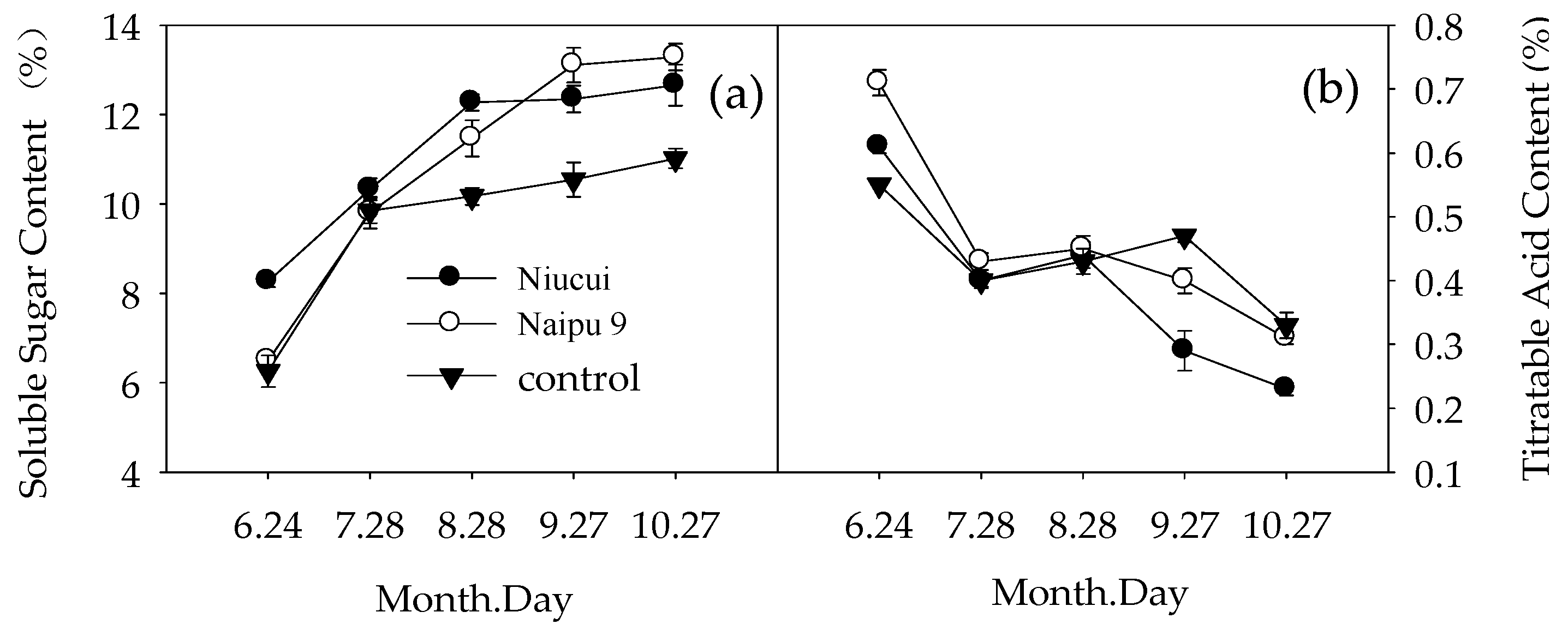
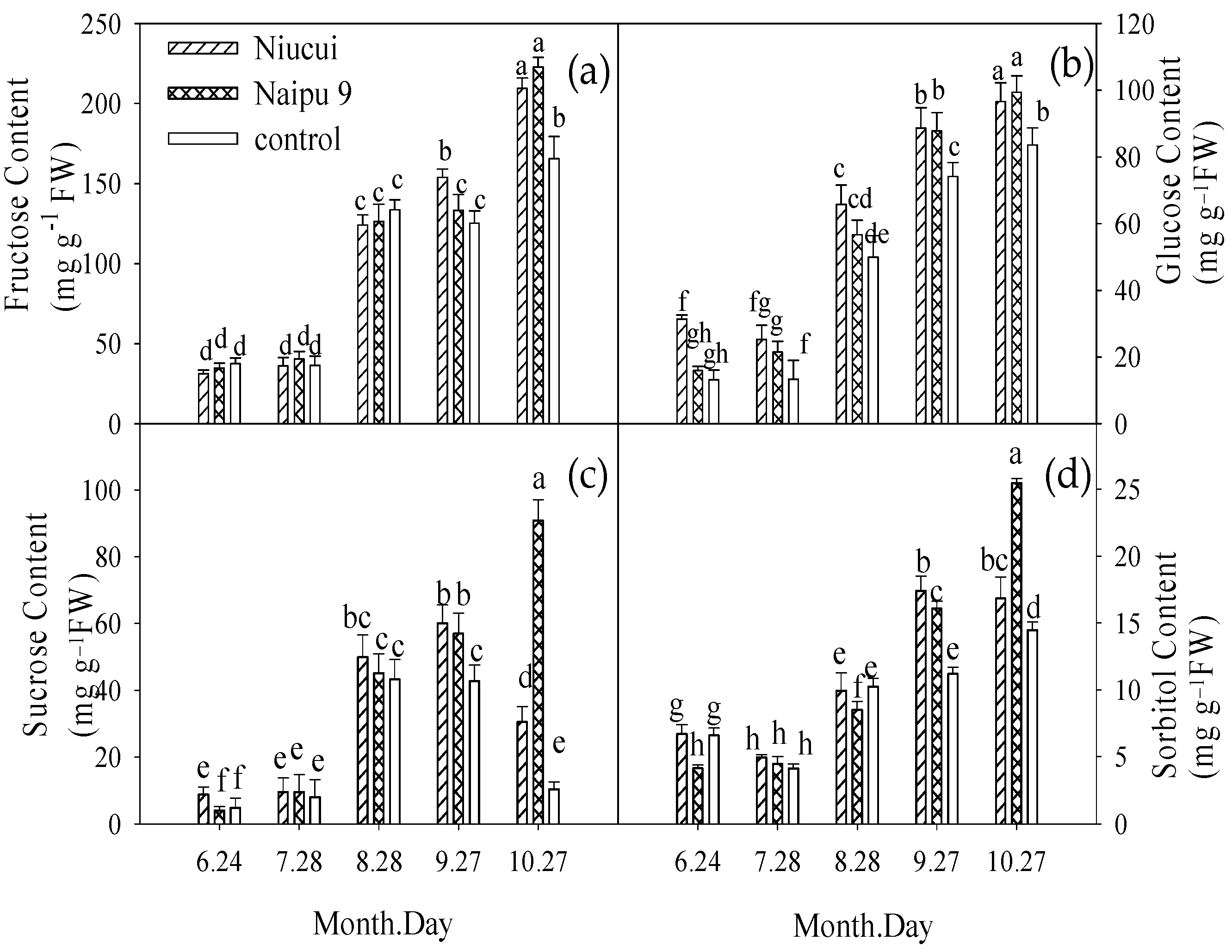
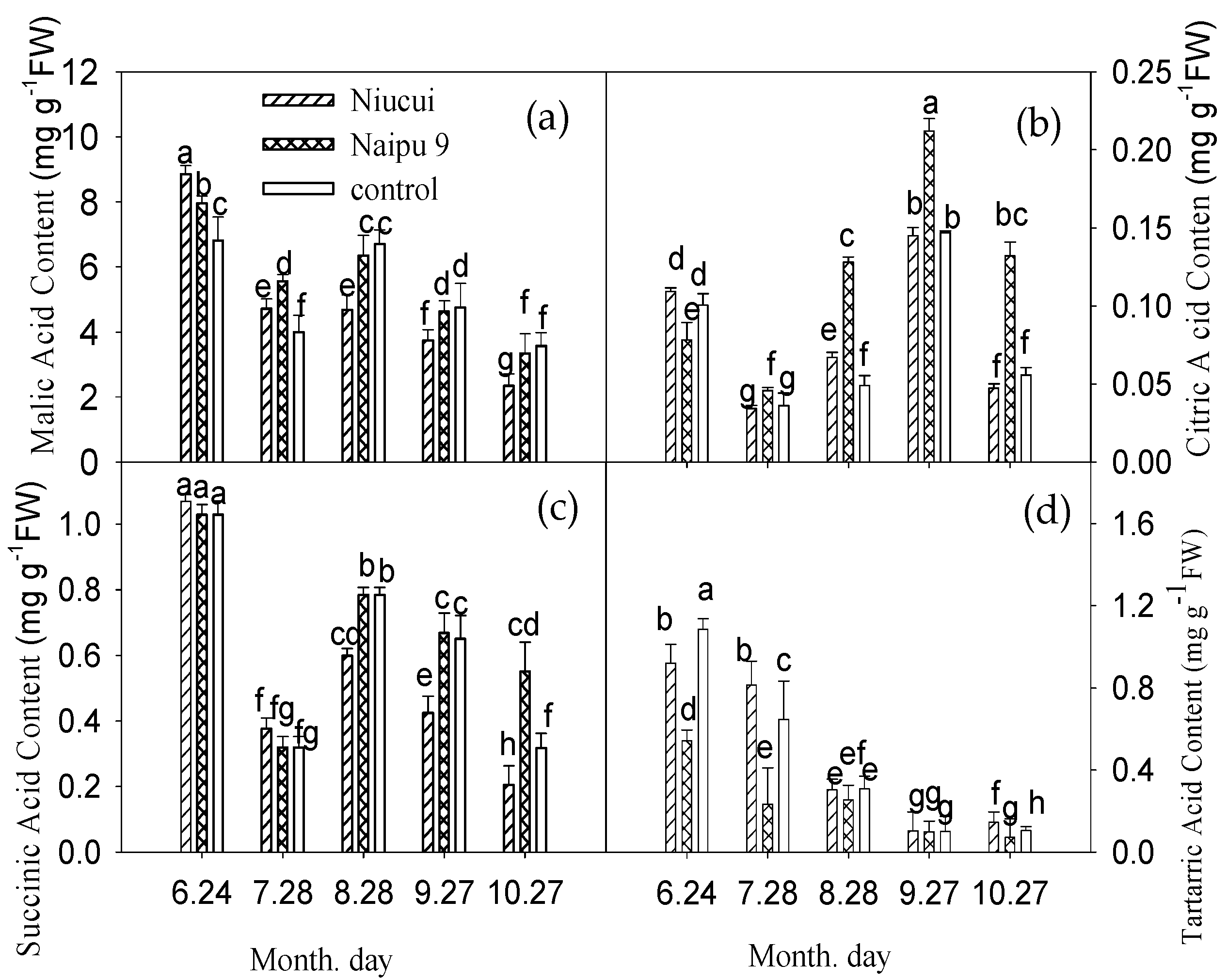
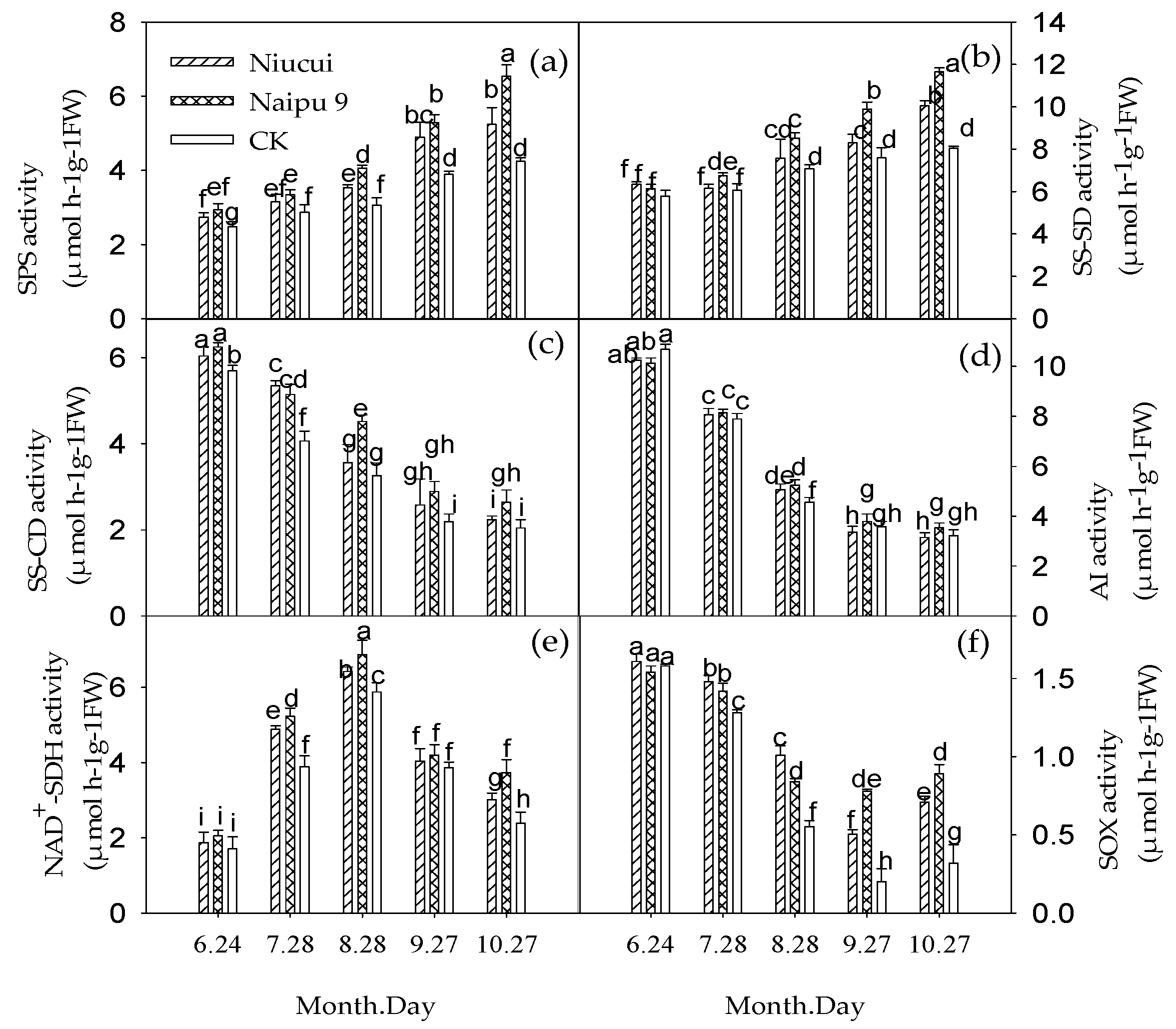
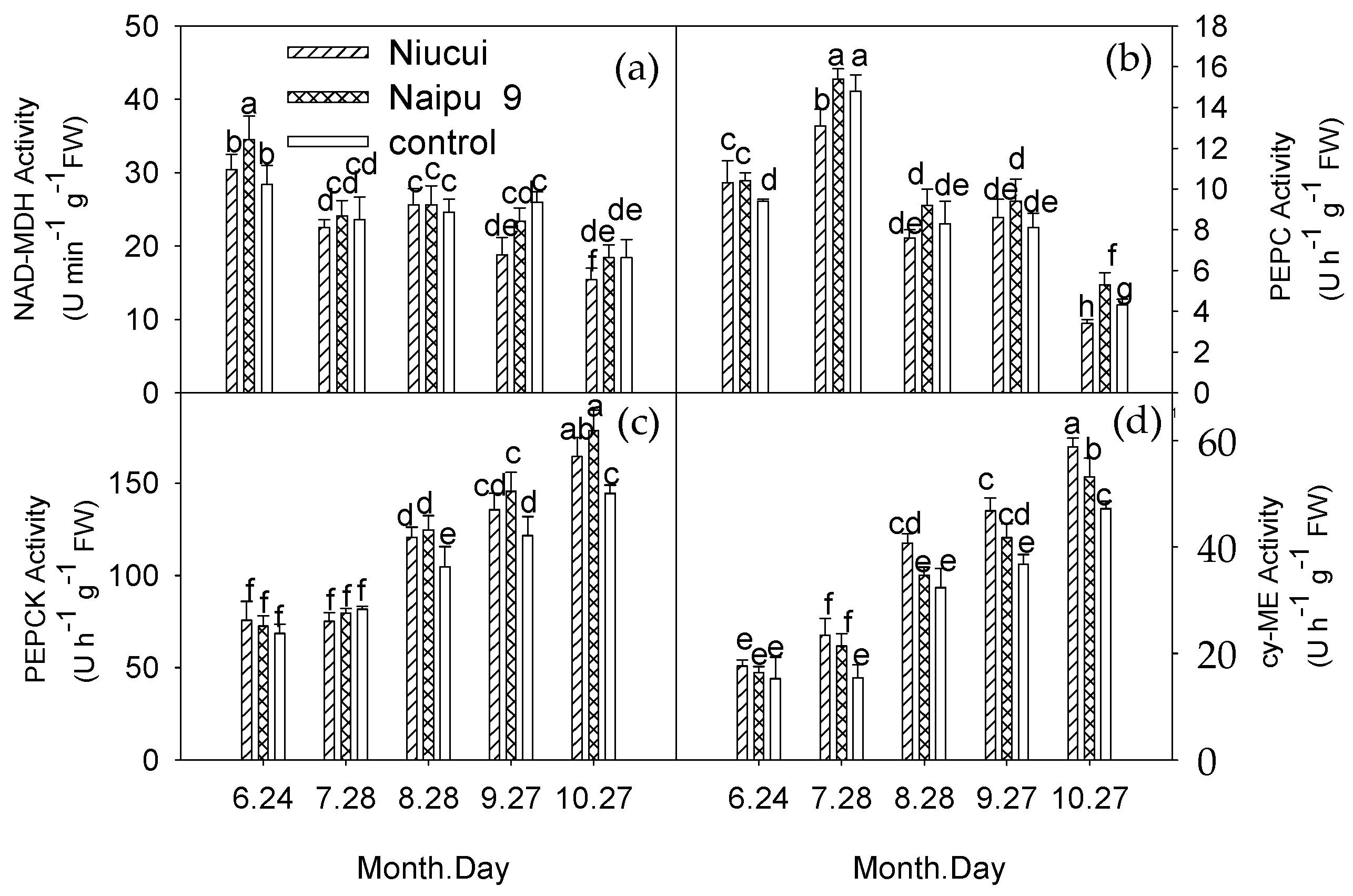
| Treatment | Single Fruit Weight (g) | Fruit Shape Index | Coloring Index (%) | Finish Index (%) | Chromatic Aberration | ||
|---|---|---|---|---|---|---|---|
| L * | a * | b * | |||||
| Niucui | 200.1 ± 21.5 ab | 0.862 ± 0.0029 b | 81.25 ± 2.37 a | 73.33 ± 3.25 b | 49.30 ± 3.55 b | 27.62 ± 3.75 ab | 12.62 ± 2.03 b |
| Naipu 9 | 206.8 ± 33.1 a | 0.891 ± 0.032 a | 83.57 ± 2.66 a | 82.81 ± 3.33 a | 52.94 ±4.52 a | 25.65 ± 2.98 b | 14.95 ± 1.33 a |
| control | 184.1 ± 20.1 b | 0.854 ± 0.041 b | 75.01 ± 4.80 b | 70.00 ± 3.78 b | 49.07 ± 3.99 b | 29.38 ± 4.82 a | 12.91 ± 2.44 b |
| Treatment | Firmness (kg/cm2) | SSC (%) | Soluble Sugar Content (%) | Titratable Acid Content (%) | Sugar–Acid Ratio | VC Content (mg/100 g) |
|---|---|---|---|---|---|---|
| Niucui | 7.43 ± 0.41 b | 14.4 ± 0.9 b | 12.66 ± 0.56 b | 0.231 ± 0.009 c | 55.04 ± 4.81 a | 8.17 ± 0.558 a |
| Naipu 9 | 8.29 ± 0.49 a | 15.9 ± 0.8 a | 13.29 ± 0.51 a | 0.312 ± 0.006 b | 42.87 ± 5.13 b | 8.10 ± 0.712 a |
| control | 7.19 ± 0.52 b | 13.8 ± 0.9 b | 11.02 ± 0.30 c | 0.332 ± 0.007 a | 33.39 ± 4.99 c | 6.26 ± 0.495 b |
| Element | Treatment | Month.Day | ||||
|---|---|---|---|---|---|---|
| 6.24 | 7.28 | 8.28 | 9.27 | 10.27 | ||
| Ca (%) | Niucui | 2.64 ± 0.14 a | 3.55 ± 0.18 a | 1.68 ± 0.07 a | 2.54 ± 0.14 a | 2.73 ± 0.05 a |
| Naipu 9 | 2.30 ± 0.08 b | 2.62 ± 0.14 b | 1.53 ± 0.06 ab | 2.12 ± 0.08 b | 2.15 ± 0.13 b | |
| control | 1.61 ± 0.04 c | 2.28 ± 0.08 c | 1.32 ± 0.04 c | 1.94 ± 0.10 c | 2.05 ± 0.07 bc | |
| Mg (g/kg) | Niucui | 0.28 ± 0.01 b | 0.17 ± 0.02 b | 1.18 ± 0.02 a | 2.34 ± 0.12 ab | 2.28 ± 0.10 ab |
| Naipu 9 | 0.37 ± 0.01 a | 0.32 ± 0.01 a | 1.19 ± 0.02 a | 2.46 ± 0.07 a | 2.39 ± 0.05 a | |
| control | 0.28 ± 0.11 b | 0.17 ± 0.05 b | 1.14 ± 0.06 b | 2.25 ± 0.13 b | 2.19 ± 0.11 b | |
| B (mg/kg) | Niucui | 103.59 ± 8.02 a | 128.95 ± 8.46 a | 64.82 ± 3.64 a | 96.70 ± 5.89 a | 93.16 ± 0.52 a |
| Naipu 9 | 54.53 ± 2.98 b | 80.31 ± 4.56 b | 59.56 ± 5.44 b | 65.86 ± 6.44 b | 72.51 ± 1.23 b | |
| control | 34.41 ± 2.56 c | 57.29 ± 6.78 c | 38.28 ± 0.88 c | 61.23 ± 2.84 c | 63.92 ± 2.54 c | |
| Cu (mg/kg) | Niucui | 32.40 ± 0.46 a | 18.65 ± 1.43 a | 22.87 ± 2.41 a | 15.42 ± 1.88 b | 12.87 ± 3.06 ab |
| Naipu 9 | 28.99 ± 1.84 b | 16.46 ± 0.94 b | 22.93 ± 1.46 a | 14.06 ± 2.42 c | 10.18 ± 1.82 c | |
| control | 23.94 ± 3.06 c | 10.05 ± 0.46 c | 21.02 ± 2.04 a | 16.25 ± 0.86 a | 13.13 ± 0.68 a | |
| Zn (mg/kg) | Niucui | 27.00 ± 3.28 b | 66.73 ± 6.62 a | 72.60 ± 4.05 a | 55.96 ± 3.42 a | 23.75 ± 1.08 b |
| Naipu 9 | 38.59 ± 0.44 a | 30.58 ± 2.89 b | 35.36 ± 3.04 bc | 36.01 ± 2.66 c | 23.36 ± 1.48 b | |
| control | 38.71 ± 2.78 a | 33.51 ± 0.98 b | 38.94 ± 4.06 b | 51.00 ± 5.64 ab | 35.51 ± 2.35 a | |
| Element | Treatment | Month.Day | ||||
|---|---|---|---|---|---|---|
| 6.24 | 7.28 | 8.28 | 9.27 | 10.27 | ||
| Ca (g/kg) | Niucui | 1.99 ± 0.08 a | 1.95 ± 0.04 a | 0.73 ± 0.02 a | 0.67 ± 0.04 a | 0.78 ± 0.04 a |
| Naipu 9 | 1.70 ± 0.06 b | 1.66 ± 0.03 bb | 0.53 ± 0.03 b | 0.63 ± 0.06 ab | 0.69 ± 0.02 b | |
| control | 1.32 ± 0.04 c | 1.19 ± 0.04 c | 0.49 ± 0.01 bc | 0.57 ± 0.01 b | 0.61 ± 0.03 b | |
| Mg (g/kg) | Niucui | 0.07 ± 0.01 c | 0.11 ± 0.01 b | 0.65 ± 0.01 c | 1.54 ± 0.06 b | 1.07 ± 0.03 b |
| Naipu 9 | 0.17 ± 0.01 a | 0.18 ± 0.02 a | 0.86 ± 0.03 a | 1.93 ± 0.05 a | 1.57 ± 0.08 a | |
| control | 0.11 ± 0.02 b | 0.13 ± 0.01 b | 0.77 ± 0.04 b | 1.54 ± 0.01 b | 1.01 ± 0.02 b | |
| B (mg/kg) | Niucui | 120.80 ± 10.02 a | 97.69 ± 5.64 a | 105.11± 11.05 a | 90.62 ± 8.46 a | 62.45 ± 3.56 a |
| Naipu 9 | 96.49 ± 6.84 b | 74.98 ± 5.66 b | 78.83 ± 5.89 b | 54.40 ± 3.64 b | 54.85 ± 0.85 b | |
| control | 45.01 ± 2.46 c | 32.39 ± 1.08 c | 61.32 ± 8.42 c | 48.35 ± 2.64 c | 42.73 ± 0.76 c | |
| Cu (mg/kg) | Niucui | 17.37 ± 0.49 c | 14.25 ± 0.68 b | 11.90 ± 0.22 b | 12.61 ± 0.34 b | 10.16 ± 0.18 b |
| Naipu 9 | 24.16 ± 0.68 ab | 18.40 ± 0.10 a | 12.03 ± 0.28 ab | 15.61 ± 0.42 a | 10.43 ± 0.23 b | |
| control | 26.11 ± 1.20 a | 19.32 ± 1.12 a | 13.12 ± 0.64 a | 16.66 ± 0.52 a | 13.20 ± 0.84 a | |
| Zn (mg/kg) | Niucui | 81.89 ± 4.66 a | 53.07 ± 5.46 a | 25.75 ± 2.44 a | 20.97 ± 2.13 b | 16.86 ± 0.84 b |
| Naipu 9 | 23.18 ± 1.08 b | 21.38 ± 2.34 b | 24.61 ± 3.46 a | 30.38 ± 1.64 a | 20.80 ± 2.42 a | |
| control | 25.15 ± 0.88 b | 22.29 ± 1.22 b | 25.55 ± 4.02 a | 21.75 ± 1.84 b | 12.66 ± 1.45 c | |
| Month.Day | Chloroplast Pigment | Chloroplast Pigment Content (mg/g) | ||
|---|---|---|---|---|
| Niucui | Naipu 9 | Control | ||
| 5.24 | Chl | 6.61 ± 0.38 a | 6.57 ± 0.37 a | 6.60 ± 0.28 a |
| Car | 2.53 ± 0.05 a | 2.44 ± 0.03 ab | 2.51 ± 0.11 a | |
| 6.24 | Chl | 7.06 ± 0.18 a | 7.12 ± 0.12 a | 6.98 ± 0.29 b |
| Car | 2.63 ± 0.11 ab | 2.74 ± 0.02 a | 2.53 ± 0.09 bc | |
| 7.28 | Chl | 6.71 ± 0.09 a | 6.75 ± 0.05 a | 6.05 ± 0.11 b |
| Car | 1.62 ± 0.06 b | 1.89 ± 0.03 a | 1.53 ± 0.03 c | |
| 8.28 | Chl | 4.91 ± 0.09 b | 5.55 ± 0.05 a | 4.85 ± 0.11 b |
| Car | 0.35 ± 0.06 b | 0.42 ± 0.03 a | 0.33 ± 0.03 b | |
| 9.27 | Chl | 3.62 ± 0.09 b | 3.89 ± 0.05 a | 3.56 ± 0.03 c |
| Car | 0.24 ± 0.05 ab | 0.25 ± 0.01 a | 0.23 ± 0.04 b | |
| 10.27 | Chl | 2.27 ± 0.01 ab | 2.37 ± 0.15 a | 2.05 ± 0.12 c |
| Car | 0.29 ± 0.03 b | 0.31 ± 0.05 a | 0.24 ± 0.04 c | |
| Month.Day | Pn (µmol m−2 s−1) | ||
|---|---|---|---|
| Niucui | Naipu 9 | Control | |
| 5.24 | 18.9 ± 1.9 a | 19.3 ± 1.4 a | 19.0 ± 0.4 a |
| 6.24 | 19.4 ± 3.6 b | 23.4 ± 1.7 a | 18.6 ± 3.8 b |
| 7.28 | 20.6 ± 2.3 a | 21.5 ± 1.1 a | 18.7 ± 1.8 b |
| 8.28 | 13.7 ± 0.6 b | 18.7 ± 3.5 a | 13.7 ± 0.2 b |
| 9.27 | 14.6 ± 0.9 b | 18.1 ± 0.5 a | 11.5 ± 1.2 c |
| 10.27 | 17.1 ± 0.8 a | 18.5 ± 0.8 a | 12.7 ± 1.8 b |
| Month.Day | Gs (mmol m−2 s−1) | ||
|---|---|---|---|
| Niucui | Naipu 9 | Control | |
| 5.24 | 257.0 ± 5.0 a | 257 ± 10.2 a | 260 ± 6.9 a |
| 6.24 | 266.7 ± 39.2 b | 347.8 ± 62.7 a | 246.1 ± 31.3 b |
| 7.28 | 261.7 ± 32.3 b | 351.7 ± 56.8 a | 253.0 ± 47.1 b |
| 8.28 | 180.7 ± 16.2 ab | 228.0 ± 15.6 a | 97.5 ± 18.2 b |
| 9.27 | 114.4 ± 19.1 ab | 120.7 ± 10.0 a | 91.6 ± 13.0 b |
| 10.27 | 98.5 ± 11.5 ab | 107.3 ± 6.5 a | 89.8 ± 12.3 b |
| Month.Day | Tr (mmol m−2 s−1) | ||
|---|---|---|---|
| Niucui | Naipu 9 | Control | |
| 5.24 | 5.3 ± 0.3 a | 5.1 ± 0.1 a | 5.5 ± 0.8 a |
| 6.24 | 4.5 ± 0.9 b | 6.2 ± 0.6 a | 4.4 ± 1.0 b |
| 7.28 | 4.3 ± 0.5 b | 5.3 ± 0.9 a | 4.0 ± 0.3 b |
| 8.28 | 4.2 ± 0.5 b | 5.2 ± 0.3 a | 2.4 ± 0.3 c |
| 9.27 | 3.2 ± 0.4 ab | 3.3 ± 0.8 a | 2.5 ± 0.3 b |
| 10.27 | 1.9 ± 0.4 a | 2.1 ± 0.3 a | 1.8 ± 0.2 a |
| Month.Day | Ci (μmol mol−1) | ||
|---|---|---|---|
| Niucui | Naipu 9 | Control | |
| 5.24 | 210.7 ± 16.2 a | 205.7 ± 7.6 a | 208.5 ± 18.6 a |
| 6.24 | 200.0 ± 16.7 b | 201.0 ± 7.9 b | 221.6 ± 12.8 a |
| 7.28 | 186.7 ± 9.3 a | 193.1 ± 18.2 a | 189.6 ± 14.3 a |
| 8.28 | 181.5 ± 7.8 b | 165.0 ± 12.3 b | 230.0 ± 12.2 a |
| 9.27 | 143.9 ± 8.5 b | 117.8 ± 5.4 c | 182.0 ± 10.5 a |
| 10.27 | 190.6 ± 10.5 a | 123.0 ± 6.4 b | 192.8 ± 12.2 a |
Publisher’s Note: MDPI stays neutral with regard to jurisdictional claims in published maps and institutional affiliations. |
© 2022 by the authors. Licensee MDPI, Basel, Switzerland. This article is an open access article distributed under the terms and conditions of the Creative Commons Attribution (CC BY) license (https://creativecommons.org/licenses/by/4.0/).
Share and Cite
Wang, G.; Wang, J.; Han, X.; Chen, R.; Xue, X. Effects of Spraying Calcium Fertilizer on Photosynthesis, Mineral Content, Sugar–Acid Metabolism and Fruit Quality of Fuji Apples. Agronomy 2022, 12, 2563. https://doi.org/10.3390/agronomy12102563
Wang G, Wang J, Han X, Chen R, Xue X. Effects of Spraying Calcium Fertilizer on Photosynthesis, Mineral Content, Sugar–Acid Metabolism and Fruit Quality of Fuji Apples. Agronomy. 2022; 12(10):2563. https://doi.org/10.3390/agronomy12102563
Chicago/Turabian StyleWang, Guiping, Jinzheng Wang, Xueping Han, Ru Chen, and Xiaomin Xue. 2022. "Effects of Spraying Calcium Fertilizer on Photosynthesis, Mineral Content, Sugar–Acid Metabolism and Fruit Quality of Fuji Apples" Agronomy 12, no. 10: 2563. https://doi.org/10.3390/agronomy12102563
APA StyleWang, G., Wang, J., Han, X., Chen, R., & Xue, X. (2022). Effects of Spraying Calcium Fertilizer on Photosynthesis, Mineral Content, Sugar–Acid Metabolism and Fruit Quality of Fuji Apples. Agronomy, 12(10), 2563. https://doi.org/10.3390/agronomy12102563





